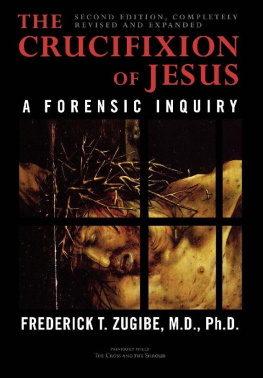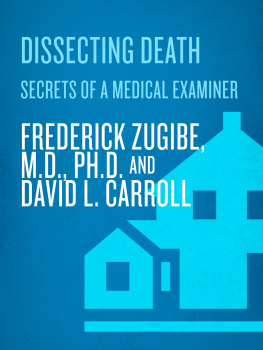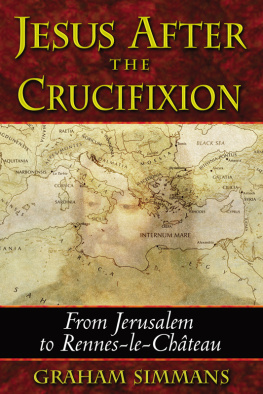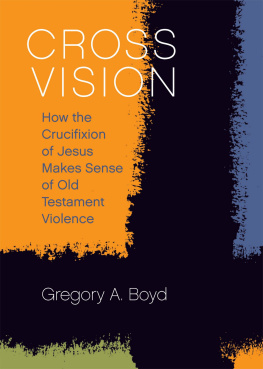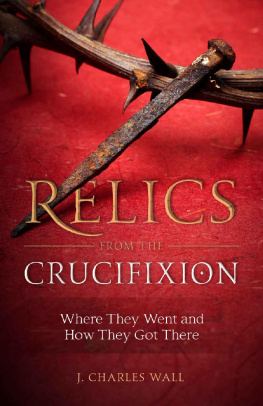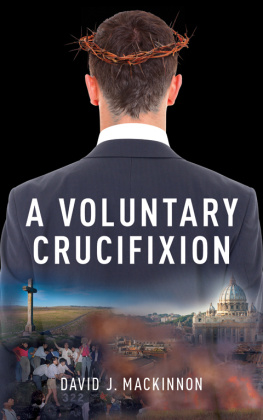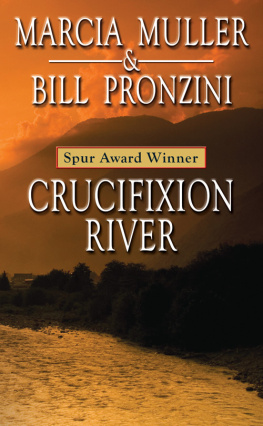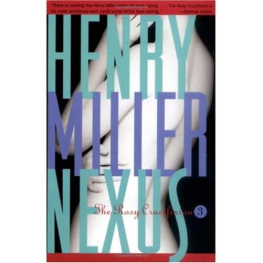THE
CRUCIFIXION
OF JESUS
THE
CRUCIFIXION
OF JESUS
A FORENSIC INQUIRY
FREDERICK T. ZUGIBE, M.D., PH.D.

Copyright 2005 by Frederick Zugibe
All rights reserved. No part of this book may be reproduced or transmitted in any form or by any means, electronic or mechanical, including photocopying, recording, or by any information storage and retrieval system, without prior permission in writing from the publisher.
M. Evans and Company, Inc.
216 East 49th Street
New York, NY 10017
Library of Congress Cataloging-in-Publication Data
Zugibe, Frederick T. (Frederick Thomas)
The crucifixion of Jesus : a forensic inquiry / Frederick T. Zugibe.
p. cm.
Rev. ed. of: The Cross and the shroud. cl988.
Includes bibliographical references and index.
ISBN 1-59077-070-6
ISBN: 978-1-59077-070-2
1. Jesus Christ--Crucifixion. 2. Holy Shroud. 3. Forensic pathology.
4. Crucifixion--Physiological aspects. I. Zugibe, Frederick T.
(Frederick Thomas), 1928- Cross and the shroud. II. Title.
BT450.Z83 2005
232.963--dc22
2004024210
Designed and typeset by Evan Johnston
Printed in the United States of America
0 9 8 7 6 5 4 3 2
CONTENTS
Illustrations
ACKNOWLEDGMENTS
I wish to acknowledge some very choice people who were essential to the success of my book; my wife, Catherine, who has been the driving force for all of my endeavors, has stood at my side through thick and thin and has served as a constant inspiration and a source of inestimable advice for more than 52 years of marriage. I am indebted to two fantastic priests who were the prime movers in my crucifixion studies; Father Angelus Shaughnessey, OFM Cap, and Father Peter Weyland, SVD. Father Angelus stimulated me to continue my crucifixion studies, started me on my crucifixion lectures, and provided me with continual scriptural support. Father Weyland, who was also a sculptor and blacksmith, urged me to perform suspension experiments in an attempt to clear up some of the controversies regarding asphyxiation and replicated the original cross for all of my experiments. My thanks also go out to my son Fred, a board-certified cardiologist, who assisted me in my early experiments when he was a young boy, and my son Tom, an attorney and ; for improving the quality of many of my photos; and for his valuable discussions and advice in Shroud research. I wish to acknowledge my editor Mr. Matt Harper. His meticulous review of every paragraph, and many suggestions, has greatly enhanced the quality of the book.
INTRODUCTION
My interest in the crucifixion began in 1948 when I was a college student majoring in biology. Following a discussion of an article that had appeared in the Catholic Medical Guardian entitled The Physical Cause of the Death of Our Lord by J. R. Whitaker, my professor asked me to write a term paper on the subject because I was very critical of the piece. I delved into everything I could find and wrote a thirty-page paper with illustrations and bibliography. The research launched my lifelong study of the medical and scientific aspects of the crucifixion.
The investigation was by far the most intricate, intriguing, and challenging experience of my career. As a Chief Medical Examinerforensic pathologist, I have investigated some of the most complicated, puzzling, bizarre, and horrific forensic cases that included homicides, suicides, drug deaths, vehicular accidents, suspicious deaths, child abuse cases, poisonings, and the like. None compared to the intricacies that confronted me during my probe into the death of Jesus. In a sense, the process was like conducting an autopsy across the centuries. This lifelong study challenged the entire range of my scientific and medical background in the areas of forensic pathology, medicine, cardiology, anatomy, biochemistry, physiology, biophysics, physics, computer science, pharmacology, inorganic and organic chemistry, and botany.
The Cross and the Shroud, my previous book written in 1988, represented the culmination of more than 38 years of research into the medical aspects of crucifixion and the Shroud of Turin. Since the publication of that work, I have conducted many new crucifixion experiments and, concomitantly, the body of literature on the subject has grown markedly. This new book represents the culmination of more than 53 yearsa fresh look at the research into the medical and scientific aspects of crucifixion.
In 1950, when I came across Pierre Barbets book, A Doctor at Calvary, I was enthralled with the subject and lectured to numerous audiences on his findings. However, it was not until I attended graduate school at Columbia University to pursue a Ph.D. in human anatomy, that I started to realize that Barbets observations and conclusions were medically and scientifically inaccurate. For example, the anatomy students had a number of mnemonics to memorize various anatomical structures in a particular order. When I applied one such mnemonic for the bones in the wrist, I realized that Destots space was on the side of the wrist opposite to where the Shroud of Turin showed the wrist wound. I then began to investigate Barbets missing thumb theory, his asphyxiation hypotheses, and more. It was then that I realized that Barbet had not applied the principles of the scientific method to his various hypothesessine qua non in scientific researchyet his hypotheses were published in myriad journals, books, magazines, documentaries, and movies, and quoted ad infinitum. Subsequently, after extensive experimentation, I was able to demonstrate that his other hypotheses were also untenable.
In science, particularly in specialized areas of research, one must remember that things are not always what they seem to be. This is especially true in crucifixion and Shroud research where the literature is badly contaminated with papers written by individuals who publish and lecture outside their areas of expertise and those well-intentioned, ubiquitous dilettantes without any expertise at all.
Much to my dismay, my research revealed that the literature related to the medical aspects of the crucifixion and Shroud was inundated with a farrago of articles by unqualified individuals including surgeons, radiologists, general practitioners, psychiatrists, scientists, scholars in unrelated fields, and even laymen whose conclusions were based on anecdotal, a priori speculations rather than the results of scientific experimentation, a sine qua non required by the tenets of the scientific method. In addition, I found over the years that multitudes of articles have been published by sincere individuals whose intentions were good, but who did not possess the necessary education, training, and experience to evaluate and interpret the information and render valid conclusions or who, influenced by their religious fervor, reached untenable and erroneous conclusions, argumentum ad hominum. I have encountered this on numerous occasions. Kraemer (1992) poignantly points out, When those without adequate training in a particular field are permitted to influence progress in a particular field(even those with excellent training in another field), the problem is not merely that they are likely to produce lies, but that their lies may impede others search for truth in that field. It is vital to medical research that amateur science be discouraged, that appropriate professional training or oversight in each field be required before proposals are approved or papers accepted for publication.

